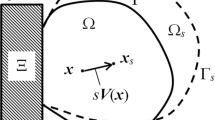Abstract
This paper is concerned with the development of a mixed variational formulation and computational procedure for the shape optimization problem of linear elastic solids in possible contact with a rigid foundation. The objective is to minimize the maximum value of the von Mises equivalent stress in a body (non-differentiable objective function), subject to a constraint on its volume and bound constraints on the design. For design purposes, the contact boundary is considered fixed.
A finite element model that is appropriate for the mixed formulation is utilized in the discretization of the state and adjoint state equations. An elliptical mesh generator was used to generate the finite element mesh at each new design. The computational model is tested in several example problems.
Similar content being viewed by others
References
Benedict, R.L.; Taylor, J.E. 1981:Optimal design for elastic bodies in contact. In: Haug, E.J.; Cea, J. (eds.)Optimization of distributed parameter structures II, pp. 1553–1599. Amsterdam: Sijthoff and Noordhoff
Bertsekas, D.P. 1982:Constrained optimization and Lagrange multiplier methods. New York: Academic Press
Braibant, V.; Fleury, C. 1984: Shape optimal design using Bsplines.Comp. Meth. Appl. Mech. Eng. 44, 247–267
Campos, L.T. 1981:A numerical analysis of a class of contact problems with friction in elastostatics. M.Sc. Thesis, The University of Texas, Austin, TX
Choi, K.K.; Seong, H.G. 1986: A domain method for shape design sensitivity analysis of built-up structures.Comp. Meth. Appl. Mech. Eng. 57, 1–15
Chung, K.Y. 1985:Shape optimization and free boundary value problems with grid adaptation. Ph.D. Thesis, The University of Michigan, Ann Arbor, MI
Dems, K.; Mróz, Z. 1978: Multiparameter structural shape optimization by the finite element method.Int. J. Num. Meth. Eng. 13, 247–263
Duvaut, G.; Lions, J.L. 1976:Inequalities in mechanics and physics. Berlin, Heidelberg, New York: Springer
Haber, R.B. 1987: Application of the Eulerian Lagrangian kinematic description to structural shape design. In: Mota Soares, C.A. (ed.)Computer aided optimal design: structural and mechanical systems, pp. 573–587. Berlin, Heidelberg, New York: Springer
Haslinger, J.; Neittaanmäki, P. 1988:Finite element approximation for optimal shape design. New York: John Wiley & Sons
Haug, E.J.; Choi, K.K.; Komkov, V. 1986:Design sensitivity analysis of structural systems. New York: Academic Press
Kikuchi, N. 1986: Adaptive grid-design methods for finite element analysis.Comp. Meth. Appl. Mech. Eng. 55, 129–160
Kikuchi, N.; Oden, J.T. 1988:Contact problems in elasticity: a study of variational inequalities and finite element methods. Philadelphia: SIAM
Murat, F.; Simon, J. 1976: Studies on optimal shape design problems. In: Cea, J. (ed.)Lectures notes in computer science 41, pp. 54–62. Berlin, Heidelberg, New York: Springer
Pedersen, P.; Laursen, C.L. 1983: Design for minimum stress concentration by finite elements and linear programming.J. Struct. Mech. 10, 375–391
Pshenichny, B.N.; Danilin, Y.M. 1978:Numerical methods in extremal problems. Moscow: Mir
Rasmussen, J. 1990: The structural optimization system CAOS.Struct. Optim. 2, 109–115
Rodrigues, H.C. 1988:Shape optimal design of elastic bodies using a mixed variational formulation. Ph.D. Thesis, The University of Michigan, Ann Arbor, MI
Rodrigues, H.C. 1989: Shape optimal design of elastic bodies using a mixed variational formulation.Comp. Meth. Appl. Mech. Eng. 69, 29–44
Sokolowski, J. 1988: Sensitivity analysis of contact problems with prescribed friction.J. Appl. Math. Opt. 19, 99–118
Sokolowski, J; Zolesio, J.P. 1987: Shape sensitivity analysis of unilateral problems.SIAM J. Math. Anal. 18, 1416–1437
Taylor, J.E.; Bendsøe, M.P. 1984: An interpretation for min-max structural design problems including a method for relaxing constraints.Int. J. Solids & Struct. 20, 301–314
Thompson, J.F.; Warsi, Z.U.A.; Mastin, C.W. 1985:Numerical grid generation foundations and applications. New York: North Holland
Zienkiewicz, O.C.; Campbell, J.S. 1973: Shape optimization and sequential linear programming. In: Gallagher, R.H.; Zienkiewicz, O.C. (eds.)Optimum structural design, pp. 109–126. London: Wiley
Author information
Authors and Affiliations
Rights and permissions
About this article
Cite this article
Rodrigues, H.C. A mixed variational formulation for shape optimization of solids with contact conditions. Structural Optimization 6, 19–28 (1993). https://doi.org/10.1007/BF01743171
Received:
Revised:
Issue Date:
DOI: https://doi.org/10.1007/BF01743171




